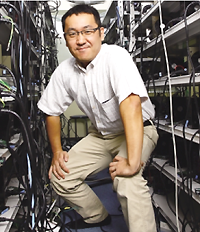Building & maintaining a cluster of GPUs
by Professor Tsuyoshi Hamada
Nagasaki Advanced Computing Center

This course is based on the experience at the Nagasaki Advanced Computing Center building a GPU cluster to win the Gordon Bell prize in the price/performance category. After several years trying, finally the coveted prize was awarded to Professor Hamada and his co-authors in 2009.
Two main sections in the course will cover the hardware & software aspects, respectively.
Hardware
The following topics will be covered:
- server and GPU racks
- air conditioning
- power supply
- network
- file servers
Based on this experience, Prof. Hamada will give tips about the choice of components, depending on the size of the cluster. He will describe things that can go wrong and how to avoid them—e.g., proper grounding, using spacers to avoid sparks!
Suggestions about power and air conditioning requirements will be offered, and suggestions about network choices. For example, if the cluster will have 36 nodes or less, choose Ethernet; for more htan 36 nodes, a better choice is Infiniband.
Some details that need attention are cable management, and power outlets; solutions to the problems that may arise in tis and other hardware issues will be suggested. Prof. Hamada will describe issus, show photographs of several stages of his cluster, and discuss pricing, sourcing, timing, and labor requirements.
Software
There are two aspects to be considered in terms of software requirements: the system configuration (operating system, file system, setting accounts) and the cluster management tools. Prof. Hamada will spend time explaining his tested solutions for these two aspects, and also demonstrate his own tools for parallel management. He will not only demonstrate, but make available his programs providing parallel shell scripts for broadcasting instructions to all nodes. He will also share his testing suite, to be used for detecting faulty gaming cards, and discuss strategies for fault-tolerant computing.
Participants in this course will have access to the wealth of knowledge obtained from building several generations of GPU clusters. Starting in March 2007 with a 1 Tflop/s system, and ending with the award-winning GPU cluster Degima with 576 GPUs.